|
Coming to America: Immigration Builds This
Nation
 The
story of immigration is inseparable from this country's history.
Discover the United States through the waves of immigration that
brought our people to America's shores and spurred a nation of
change and growth. The
story of immigration is inseparable from this country's history.
Discover the United States through the waves of immigration that
brought our people to America's shores and spurred a nation of
change and growth.
 All
Americans, with the exception of Native American, are descended
from immigrants. The greatest number of immigrants -- more than
34 million -- arrived in the United States during the 100 years
preceding 1924, when new legislation closed the country's relatively
wide-open door. All
Americans, with the exception of Native American, are descended
from immigrants. The greatest number of immigrants -- more than
34 million -- arrived in the United States during the 100 years
preceding 1924, when new legislation closed the country's relatively
wide-open door.
The first major wave of immigration after 1824 consisted primarily
of northern Europeans from Ireland, Great Britain, Germany, and
Scandinavia. The second wave of immigrants -- mainly from southern
and eastern Europe -- arrived between 1890 and 1924. Today, Mexico
and China leads the nation from which most new immigrants to
the United States now come.
Immigration, while having its roots in our history, is an
important issue for the future of our country. Make a point on
December 17th, as a Day of Inclusion of introducing the story
of Embracing Our Shared Differences and Common Goals to your
school, community, and family today with these resources:
School Resources
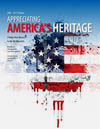 Appreciating America’s
Heritage The American Immigration Law Foundation (AILF) produces
a very valueable Teachers’ resource guide titled “Appreciating
America’s Heritage”. Each year, AILF publishes a new
edition of this guide because it is important to promote respect,
dignity and an appreciation for everyone in this country, regardless
of where you were born. By ensuring our children learn that every
person deserves respect and that celebrating multiculturalism
is at the heart of our American values, the sooner the next generation
can end the divisive rhetoric that has divided America for too
long. Appreciating America’s
Heritage The American Immigration Law Foundation (AILF) produces
a very valueable Teachers’ resource guide titled “Appreciating
America’s Heritage”. Each year, AILF publishes a new
edition of this guide because it is important to promote respect,
dignity and an appreciation for everyone in this country, regardless
of where you were born. By ensuring our children learn that every
person deserves respect and that celebrating multiculturalism
is at the heart of our American values, the sooner the next generation
can end the divisive rhetoric that has divided America for too
long.
The latest 2009 edition provides a variety of resources that
continue to keep the needs of classroom teachers, community educators
and concerned citizens in mind by providing new and innovative
lesson plans, book and film reviews as well as a brief history
of U.S. immigration. Download “Appreciating
America’s Heritage.” (PDF, 4.70 MB)
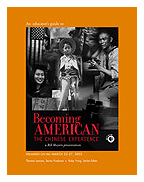 Facing History and Ourselves
delivers classroom strategies, resources and lessons that inspire
young people to take responsibility for their world by offering
teachers and students ways to confront prejudice, apathy, fear,
and violence. Their goal is to teach students to think critically,
to empathize, to recognize moral choices, to make their voices
heard, we put in their hands the possibility and the responsibility
to do the serious work demanded of us all as citizens. Facing History and Ourselves
delivers classroom strategies, resources and lessons that inspire
young people to take responsibility for their world by offering
teachers and students ways to confront prejudice, apathy, fear,
and violence. Their goal is to teach students to think critically,
to empathize, to recognize moral choices, to make their voices
heard, we put in their hands the possibility and the responsibility
to do the serious work demanded of us all as citizens.
Download An Educator's Guide to Becoming American: The Chinese
Experience (PDF, 956 KB) that describes the ways the first arrivals
from China in the 1840s, their descendants, and recent immigrants
have “become American.” It is a story about identity
and belonging that will resonate with all Americans.
 César
E. Chávez Model Curriculum The California Department
of Education's Model Curriculum - Grade Four: California: A Changing
State requires students in this grade to study the history and
development of California from earliest times to the present.
The curriculum emphasizes the role of immigration, the development
of California’s economy, agriculture and infrastructure,
its geography and the contributions of men and women of diverse
backgrounds. Students will study, in an in-depth manner, “Modern
California: Immigration, Technology and Cities”. César
E. Chávez Model Curriculum The California Department
of Education's Model Curriculum - Grade Four: California: A Changing
State requires students in this grade to study the history and
development of California from earliest times to the present.
The curriculum emphasizes the role of immigration, the development
of California’s economy, agriculture and infrastructure,
its geography and the contributions of men and women of diverse
backgrounds. Students will study, in an in-depth manner, “Modern
California: Immigration, Technology and Cities”.
Within this unit of study, special attention will be given
to the role of labor in industry and agriculture, including how
César E. Chávez, through nonviolent tactics, educated
the general public about the working conditions in agriculture
and led the movement to improve the lives of farm workers through
the César E. Chávez
Model Curriculum.
 Angel
Island Immigration Station School Tours School groups can
schedule visits to Angel Island year round. Programs about of
the Immigration Station are approximately 30-45 minutes long
and are led by park staff or volunteers. Immigration Station
programs can accommodate 120 people per weekday during the school
year. Angel
Island Immigration Station School Tours School groups can
schedule visits to Angel Island year round. Programs about of
the Immigration Station are approximately 30-45 minutes long
and are led by park staff or volunteers. Immigration Station
programs can accommodate 120 people per weekday during the school
year.
AIISF has produced an Angel
Island Immigration Station Pre-visit Guide (PDF, 274KB) to
assist educators in preparing for their trip to Angel Island
Immigration Station. This 6-page guide includes background materials,
short suggested activities, glossary, and list of resources.
 Japanese American Internment Curriculum The National Japanese
American Historical Society Education Program provides students
the tools to prepare themselves as informed citizens in a constitutional
democracy. The study of the Japanese American internment is one
that all students should reflect upon and their shared responsibility
to protect the rights of all individuals at all times. Particularly
in times of crisis, they may be called upon to make difficult
decisions that may affect their lives and those of others.
Japanese American Internment Curriculum The National Japanese
American Historical Society Education Program provides students
the tools to prepare themselves as informed citizens in a constitutional
democracy. The study of the Japanese American internment is one
that all students should reflect upon and their shared responsibility
to protect the rights of all individuals at all times. Particularly
in times of crisis, they may be called upon to make difficult
decisions that may affect their lives and those of others.
In making such critical decisions, they should be free of
prejudice, possess an understanding of due process, and become
aware of the constitutional and human rights of all people. The
Japanese American Internment
Curriculum was developed to help students become aware of,
and sensitive to, the Japanese American camp experience.
 From
Haven to Home Three hundred and fifty years ago an ancient
people first took haven in a new land. From those beginnings
until today, Jewish life in America has presented both opportunities
and challenges. In the early years, Jews fought to be treated
like everyone else, seeking the "equal footing" that
was theirs by law but not necessarily in practice. More recently,
like other minorities and ethnic groups, they have asserted their
right to be different and to have those differences accommodated
and accepted by society-at-large. From
Haven to Home examines the Jewish experience in the United
States. From
Haven to Home Three hundred and fifty years ago an ancient
people first took haven in a new land. From those beginnings
until today, Jewish life in America has presented both opportunities
and challenges. In the early years, Jews fought to be treated
like everyone else, seeking the "equal footing" that
was theirs by law but not necessarily in practice. More recently,
like other minorities and ethnic groups, they have asserted their
right to be different and to have those differences accommodated
and accepted by society-at-large. From
Haven to Home examines the Jewish experience in the United
States.
 Korean
Americans: A Century of Experience The Smithsonian Institution
Asian Pacific American Program details the history of Koreans
in America with the Korean Americans:
A Century of Experience when the S.S. Gaelic arrived in Honolulu
Harbor, carrying the first significant group of Korean immigrants
to the New World. Korean
Americans: A Century of Experience The Smithsonian Institution
Asian Pacific American Program details the history of Koreans
in America with the Korean Americans:
A Century of Experience when the S.S. Gaelic arrived in Honolulu
Harbor, carrying the first significant group of Korean immigrants
to the New World.
Today, Korean American populations exist throughout the United
States, with the largest communities residing in Los Angeles,
New York, Chicago, and Northern Virginia. The 2000 U.S. Census
reports that the population of Korean Americans is well over
one million and that number is growing briskly.
Community Resources
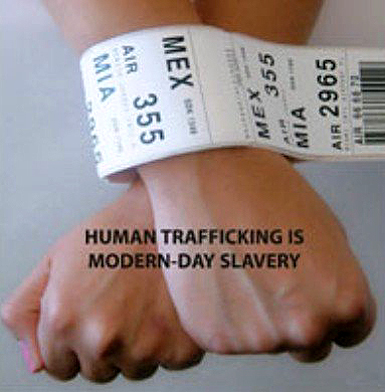 The California Immigrant
Policy Center is a clearinghouse of reliable information,
advocacy tools, education and research materials regarding California’s
immigrants and their economic, social, and demographic impact
on our state and nation. Under both federal and state law, undocumented
immigrants who are victims of human trafficking, domestic violence
or other serious crimes may be eligible for certain benefits
or social services designed to allow them to escape their abusers. The California Immigrant
Policy Center is a clearinghouse of reliable information,
advocacy tools, education and research materials regarding California’s
immigrants and their economic, social, and demographic impact
on our state and nation. Under both federal and state law, undocumented
immigrants who are victims of human trafficking, domestic violence
or other serious crimes may be eligible for certain benefits
or social services designed to allow them to escape their abusers.
The California Immigrant Policy Center has issued an excellent
booklet titiled, Benefits for
Immigrant Victims of Human Trafficking (PDF, 1.36 MB) explaining
those benefits and how undocumented immigrants who suffer from
abuse may apply for them.
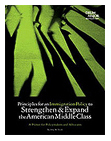 The Drum Major Institute
for Public Policy showcases progressive policies that have
worked to advance social and economic justice. The debate over
the future of immigration policy in this country is expected
to become one of the most pressing policy conversations in the
year ahead. That debate can be a positive one that helps us to
define our future as a nation or a negative one that draws upon
fears and inaccuracies for the purpose of dividing people who
should be united in the common cause of preserving access to
the American Dream. The institute offers an evaluation of immigration
policy that operates from the basic principle that immigration
policy is sound only if it also helps to strengthen and expand
America's middle class. The Drum Major Institute
for Public Policy showcases progressive policies that have
worked to advance social and economic justice. The debate over
the future of immigration policy in this country is expected
to become one of the most pressing policy conversations in the
year ahead. That debate can be a positive one that helps us to
define our future as a nation or a negative one that draws upon
fears and inaccuracies for the purpose of dividing people who
should be united in the common cause of preserving access to
the American Dream. The institute offers an evaluation of immigration
policy that operates from the basic principle that immigration
policy is sound only if it also helps to strengthen and expand
America's middle class.
The institute offers Principles for an Immigration Policy
to Strengthen and Expand the American
Middle Class: A Primer for Policymakers and Advocates (PDF, 468 KB) in response
to current conversations about immigration.
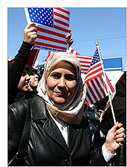 Muslim
Americans: A National Portrait The national conversation
about Muslim Americans went from a whisper to a roar as the United
States attempted to protect itself and heal after the horrific
terrorist attacks on Sept. 11, 2001. Suddenly, a group that had
long been overlooked became a subject of scrutiny. However, viewing
the diverse Muslim American community primarily through the prism
of national security would be an unfortunate oversimplification
of a great American story. Muslim
Americans: A National Portrait The national conversation
about Muslim Americans went from a whisper to a roar as the United
States attempted to protect itself and heal after the horrific
terrorist attacks on Sept. 11, 2001. Suddenly, a group that had
long been overlooked became a subject of scrutiny. However, viewing
the diverse Muslim American community primarily through the prism
of national security would be an unfortunate oversimplification
of a great American story.
In the first-ever nationally representative study of a randomly
selected sample of Muslim Americans that was derived from more
than 300,000 interviews of U.S. households, Gallup’s Center
for Muslim Studies offers a snapshot of this community. Muslim
Americans: A National Portrait (PDF, 5.36 MB) is meant as
a foundational document to highlight Muslim American ethnic,
economic, and political diversity and set the stage for future
research.
 In
Motion: The African-American Migration Experience The Schomburg
Center for Research in Black Culture is a national research library
devoted to collecting, preserving and providing access to resources
documenting the experiences of peoples of African descent throughout
the world. In Motion: The African-American
Migration Experience presents more than 16,500 pages of texts,
8,300 illustrations, and more than 60 maps chronicling the African-American
Migration Experience including the Transatlantic Slave Trade
from 1450-1867, the American Domestic Slave Trade from 1760-1865,
and the Western Migration of Black Americans from 1840-1970. In
Motion: The African-American Migration Experience The Schomburg
Center for Research in Black Culture is a national research library
devoted to collecting, preserving and providing access to resources
documenting the experiences of peoples of African descent throughout
the world. In Motion: The African-American
Migration Experience presents more than 16,500 pages of texts,
8,300 illustrations, and more than 60 maps chronicling the African-American
Migration Experience including the Transatlantic Slave Trade
from 1450-1867, the American Domestic Slave Trade from 1760-1865,
and the Western Migration of Black Americans from 1840-1970.
 Armenian
Americans in California More than a century ago, Armenians
began to leave their country as a result of genocide in their
homeland. There are more than one million Armenians in the United
States today. Approximately half of this population resides in
California, largely in the cities of Glendale, Fresno, Los Angeles,
and San Francisco. Armenian
Americans in California More than a century ago, Armenians
began to leave their country as a result of genocide in their
homeland. There are more than one million Armenians in the United
States today. Approximately half of this population resides in
California, largely in the cities of Glendale, Fresno, Los Angeles,
and San Francisco.
The first Armenian to arrive in California in 1874 and had
a key role in the development of the fig industry in Fresno and
exported them worldwide. Similarly, Armenian
Americans in California played instrumental roles in the
development of the bulgur (cracked wheat), grape, and raisin
industries.
 Filipino
American History In 1763, Filipino seamen established a settlement
in what is now known as Louisiana. Waiting to be told are the
stories of the descendants of those "Spanish Colonial"
Seamen, early workers in sugar plantations of Hawai'i, men who
served in the U.S. Navy since World War I, workers - who toiled
in Alaska canneries, farms in California, Arizona, Washington
and Montana; the railroads, kitchens and restaurants, as hotel
workers or houseboys, war brides and countless others who constitute
the subsequent groups of immigrants from the Philippines. The
Coalition of Collegiate Pilipino American Organizations has created
snapshot of Filipino American History
and their role in the history of California. Filipino
American History In 1763, Filipino seamen established a settlement
in what is now known as Louisiana. Waiting to be told are the
stories of the descendants of those "Spanish Colonial"
Seamen, early workers in sugar plantations of Hawai'i, men who
served in the U.S. Navy since World War I, workers - who toiled
in Alaska canneries, farms in California, Arizona, Washington
and Montana; the railroads, kitchens and restaurants, as hotel
workers or houseboys, war brides and countless others who constitute
the subsequent groups of immigrants from the Philippines. The
Coalition of Collegiate Pilipino American Organizations has created
snapshot of Filipino American History
and their role in the history of California.
Family Resources
 Why I Wear a Turban With 1.5 million in North America, Sikhs can
be found in almost all countries of the world. The tenth guru,
Guru Gobind Singh (1666-1708), gave the Sikhs their distinctive
appearance of unshorn hair, beards, turbans and kirpan, a short
dagger intended to make them easily recognizable as staunch defenders
of the weak and oppressed. Why I Wear a Turban With 1.5 million in North America, Sikhs can
be found in almost all countries of the world. The tenth guru,
Guru Gobind Singh (1666-1708), gave the Sikhs their distinctive
appearance of unshorn hair, beards, turbans and kirpan, a short
dagger intended to make them easily recognizable as staunch defenders
of the weak and oppressed.
The first Sikhs came to the United States
over a hundred years ago. They were involved in the construction
of railroads in the Pacific North-West, and the Panama Canal
in 1904. Today, Sikhs continue to make significant contributions
to American society and are amongst the most educated and prosperous
groups of Americans. Learn more from the Sikh Communications
Council's " Why I Wear a Turban," Powerpoint slideshow for your 6th grade
to middle school age child.
 Teaching
Your Family About Diversity We all want children to grow
up in a world free from bias and discrimination, to reach for
their dreams and feel that whatever they want to accomplish in
life is possible. We want them to feel included and never to
experience the pain of exclusion. Teaching
Your Family About Diversity We all want children to grow
up in a world free from bias and discrimination, to reach for
their dreams and feel that whatever they want to accomplish in
life is possible. We want them to feel included and never to
experience the pain of exclusion.
But the reality is that we do live in a world in which racism
and other forms of bias continue to affect us. Discrimination
hurts and leaves scars that can last a lifetime, affecting goals,
ambitions, life choices, and feelings of self-worth. Ultimately
racism and discrimination erodes the peace of our communities.
How can we best prepare our families to meet the challenges
and reap the benefits of the increasingly diverse world we live
in? We can raise children to celebrate and value diversity and
to be proud of themselves and their family traditions. We can
teach children to respect and value people regardless of the
color of their skin, their physical abilities, or the language
they speak. You can begin by Teaching
Your Family About Diversity.
Everyday Democracy Everyday Democracy is a national leader
in the field of civic participation and community change helps people
of different backgrounds and views talk and work together to solve
problems. As a family we can create communities that work for everyone.
The following family resources are provided by Everyday Democracy:
Toward a More Perfect Union
- The pressures of an increasingly diverse
nation are visible in many of our most complex public issues, such as
education, taxes, welfare, and immigration. Dialogue-to-change programs
help people from diverse backgrounds and experiences develop trust,
understand each other's experiences, and work together on solutions.
Facing Racism in a Diverse Nation
- Families need to face racism head-on in order to have healthy communities
and a strong country. Families working together to address racism and inequities
can help people from a variety of racial, ethnic and cultural backgrounds
examine the gaps among racial and ethnic groups where they live, explore
approaches to creating greater equity, and create lasting change in their community.
The infomation is also available in a Spanish version.
Changing Faces, Changing Communities
- For many of us, immigration is not a distant national issue; it is part of
our everyday lives. Study circles bring people from diverse backgrounds to
decide together what to do about issues such as the effect of immigration
on racial tensions, jobs, and schools, language differences, and prejudice
against immigrants.
Individual Resources
 Write a Letter of Support for ACR 76 ACR 76 needs you help. Now is the time for
you to get involved. ACR 76 will soon be heard in the California
State Assembly Judiciary Committee. Please do your part in support
of ACR 76 by writing a letter of
support. Write a Letter of Support for ACR 76 ACR 76 needs you help. Now is the time for
you to get involved. ACR 76 will soon be heard in the California
State Assembly Judiciary Committee. Please do your part in support
of ACR 76 by writing a letter of
support.
Download and Distribute Our Day of Inclusion Postcard
This Day of Inclusion Postcard is a quick reference guide that provides
ideas as to how individuals, organizations, and communittes can celebrate a Day of Inclusion.
Tolerance 101
Founded in 1991 by the Southern Poverty Law Center, Teaching
Tolerance is dedicated to reducing prejudice, improving intergroup
relations and supporting equitable school experiences for our
nation's children. Tolerance 101 (PDF, 1.33 MB) provides vital information to
promote these goals.
Explore Hidden Bias It is well known that people don't always speak
their minds, and it is suspected that people don't always know
their minds. Understanding such divergences is important to scientific
psychology.
Project
Implicit blends basic research and
educational outreach in a virtual laboratory at which visitors
can examine their own hidden biases. This new method is called
the Implicit Association Test, or IAT for short.
Hidden
Bias Tests measure unconscious, or
automatic, biases. Your willingness to examine your own possible
biases is an important step in understanding the roots of stereotypes
and prejudice in our society.
Explore Hidden History Historical and modern day images often contain
hidden messages about us, about others and about our world. These
subtle lessons lie just beneath the surface. In order to see
them, we must replace passive consumption of images with critical
analysis. Make a point to Explore
Hidden History
Volunteer in a Diverse Community
in Your City CaliforniaVolunteers is the state office that manages programs and
initiatives aimed at increasing the number of Californians engaged
in service and volunteering.
|

 The
story of immigration is inseparable from this country's history.
Discover the United States through the waves of immigration that
brought our people to America's shores and spurred a nation of
change and growth.
The
story of immigration is inseparable from this country's history.
Discover the United States through the waves of immigration that
brought our people to America's shores and spurred a nation of
change and growth. All
Americans, with the exception of Native American, are descended
from immigrants. The greatest number of immigrants -- more than
34 million -- arrived in the United States during the 100 years
preceding 1924, when new legislation closed the country's relatively
wide-open door.
All
Americans, with the exception of Native American, are descended
from immigrants. The greatest number of immigrants -- more than
34 million -- arrived in the United States during the 100 years
preceding 1924, when new legislation closed the country's relatively
wide-open door.
 Appreciating America’s
Heritage The American Immigration Law Foundation (AILF) produces
a very valueable Teachers’ resource guide titled “Appreciating
America’s Heritage”. Each year, AILF publishes a new
edition of this guide because it is important to promote respect,
dignity and an appreciation for everyone in this country, regardless
of where you were born. By ensuring our children learn that every
person deserves respect and that celebrating multiculturalism
is at the heart of our American values, the sooner the next generation
can end the divisive rhetoric that has divided America for too
long.
Appreciating America’s
Heritage The American Immigration Law Foundation (AILF) produces
a very valueable Teachers’ resource guide titled “Appreciating
America’s Heritage”. Each year, AILF publishes a new
edition of this guide because it is important to promote respect,
dignity and an appreciation for everyone in this country, regardless
of where you were born. By ensuring our children learn that every
person deserves respect and that celebrating multiculturalism
is at the heart of our American values, the sooner the next generation
can end the divisive rhetoric that has divided America for too
long. Facing History and Ourselves
delivers classroom strategies, resources and lessons that inspire
young people to take responsibility for their world by offering
teachers and students ways to confront prejudice, apathy, fear,
and violence. Their goal is to teach students to think critically,
to empathize, to recognize moral choices, to make their voices
heard, we put in their hands the possibility and the responsibility
to do the serious work demanded of us all as citizens.
Facing History and Ourselves
delivers classroom strategies, resources and lessons that inspire
young people to take responsibility for their world by offering
teachers and students ways to confront prejudice, apathy, fear,
and violence. Their goal is to teach students to think critically,
to empathize, to recognize moral choices, to make their voices
heard, we put in their hands the possibility and the responsibility
to do the serious work demanded of us all as citizens. César
E. Chávez Model Curriculum The California Department
of Education's Model Curriculum - Grade Four: California: A Changing
State requires students in this grade to study the history and
development of California from earliest times to the present.
The curriculum emphasizes the role of immigration, the development
of California’s economy, agriculture and infrastructure,
its geography and the contributions of men and women of diverse
backgrounds. Students will study, in an in-depth manner, “Modern
California: Immigration, Technology and Cities”.
César
E. Chávez Model Curriculum The California Department
of Education's Model Curriculum - Grade Four: California: A Changing
State requires students in this grade to study the history and
development of California from earliest times to the present.
The curriculum emphasizes the role of immigration, the development
of California’s economy, agriculture and infrastructure,
its geography and the contributions of men and women of diverse
backgrounds. Students will study, in an in-depth manner, “Modern
California: Immigration, Technology and Cities”. Angel
Island Immigration Station School Tours School groups can
schedule visits to Angel Island year round. Programs about of
the Immigration Station are approximately 30-45 minutes long
and are led by park staff or volunteers. Immigration Station
programs can accommodate 120 people per weekday during the school
year.
Angel
Island Immigration Station School Tours School groups can
schedule visits to Angel Island year round. Programs about of
the Immigration Station are approximately 30-45 minutes long
and are led by park staff or volunteers. Immigration Station
programs can accommodate 120 people per weekday during the school
year. Japanese American Internment Curriculum The National Japanese
American Historical Society Education Program provides students
the tools to prepare themselves as informed citizens in a constitutional
democracy. The study of the Japanese American internment is one
that all students should reflect upon and their shared responsibility
to protect the rights of all individuals at all times. Particularly
in times of crisis, they may be called upon to make difficult
decisions that may affect their lives and those of others.
Japanese American Internment Curriculum The National Japanese
American Historical Society Education Program provides students
the tools to prepare themselves as informed citizens in a constitutional
democracy. The study of the Japanese American internment is one
that all students should reflect upon and their shared responsibility
to protect the rights of all individuals at all times. Particularly
in times of crisis, they may be called upon to make difficult
decisions that may affect their lives and those of others. From
Haven to Home Three hundred and fifty years ago an ancient
people first took haven in a new land. From those beginnings
until today, Jewish life in America has presented both opportunities
and challenges. In the early years, Jews fought to be treated
like everyone else, seeking the "equal footing" that
was theirs by law but not necessarily in practice. More recently,
like other minorities and ethnic groups, they have asserted their
right to be different and to have those differences accommodated
and accepted by society-at-large.
From
Haven to Home Three hundred and fifty years ago an ancient
people first took haven in a new land. From those beginnings
until today, Jewish life in America has presented both opportunities
and challenges. In the early years, Jews fought to be treated
like everyone else, seeking the "equal footing" that
was theirs by law but not necessarily in practice. More recently,
like other minorities and ethnic groups, they have asserted their
right to be different and to have those differences accommodated
and accepted by society-at-large.  Korean
Americans: A Century of Experience The Smithsonian Institution
Asian Pacific American Program details the history of Koreans
in America with the
Korean
Americans: A Century of Experience The Smithsonian Institution
Asian Pacific American Program details the history of Koreans
in America with the  The California Immigrant
Policy Center is a clearinghouse of reliable information,
advocacy tools, education and research materials regarding California’s
immigrants and their economic, social, and demographic impact
on our state and nation. Under both federal and state law, undocumented
immigrants who are victims of human trafficking, domestic violence
or other serious crimes may be eligible for certain benefits
or social services designed to allow them to escape their abusers.
The California Immigrant
Policy Center is a clearinghouse of reliable information,
advocacy tools, education and research materials regarding California’s
immigrants and their economic, social, and demographic impact
on our state and nation. Under both federal and state law, undocumented
immigrants who are victims of human trafficking, domestic violence
or other serious crimes may be eligible for certain benefits
or social services designed to allow them to escape their abusers. The Drum Major Institute
for Public Policy showcases progressive policies that have
worked to advance social and economic justice. The debate over
the future of immigration policy in this country is expected
to become one of the most pressing policy conversations in the
year ahead. That debate can be a positive one that helps us to
define our future as a nation or a negative one that draws upon
fears and inaccuracies for the purpose of dividing people who
should be united in the common cause of preserving access to
the American Dream. The institute offers an evaluation of immigration
policy that operates from the basic principle that immigration
policy is sound only if it also helps to strengthen and expand
America's middle class.
The Drum Major Institute
for Public Policy showcases progressive policies that have
worked to advance social and economic justice. The debate over
the future of immigration policy in this country is expected
to become one of the most pressing policy conversations in the
year ahead. That debate can be a positive one that helps us to
define our future as a nation or a negative one that draws upon
fears and inaccuracies for the purpose of dividing people who
should be united in the common cause of preserving access to
the American Dream. The institute offers an evaluation of immigration
policy that operates from the basic principle that immigration
policy is sound only if it also helps to strengthen and expand
America's middle class.  Muslim
Americans: A National Portrait The national conversation
about Muslim Americans went from a whisper to a roar as the United
States attempted to protect itself and heal after the horrific
terrorist attacks on Sept. 11, 2001. Suddenly, a group that had
long been overlooked became a subject of scrutiny. However, viewing
the diverse Muslim American community primarily through the prism
of national security would be an unfortunate oversimplification
of a great American story.
Muslim
Americans: A National Portrait The national conversation
about Muslim Americans went from a whisper to a roar as the United
States attempted to protect itself and heal after the horrific
terrorist attacks on Sept. 11, 2001. Suddenly, a group that had
long been overlooked became a subject of scrutiny. However, viewing
the diverse Muslim American community primarily through the prism
of national security would be an unfortunate oversimplification
of a great American story. In
Motion: The African-American Migration Experience The Schomburg
Center for Research in Black Culture is a national research library
devoted to collecting, preserving and providing access to resources
documenting the experiences of peoples of African descent throughout
the world.
In
Motion: The African-American Migration Experience The Schomburg
Center for Research in Black Culture is a national research library
devoted to collecting, preserving and providing access to resources
documenting the experiences of peoples of African descent throughout
the world.  Armenian
Americans in California More than a century ago, Armenians
began to leave their country as a result of genocide in their
homeland. There are more than one million Armenians in the United
States today. Approximately half of this population resides in
California, largely in the cities of Glendale, Fresno, Los Angeles,
and San Francisco.
Armenian
Americans in California More than a century ago, Armenians
began to leave their country as a result of genocide in their
homeland. There are more than one million Armenians in the United
States today. Approximately half of this population resides in
California, largely in the cities of Glendale, Fresno, Los Angeles,
and San Francisco. Filipino
American History In 1763, Filipino seamen established a settlement
in what is now known as Louisiana. Waiting to be told are the
stories of the descendants of those "Spanish Colonial"
Seamen, early workers in sugar plantations of Hawai'i, men who
served in the U.S. Navy since World War I, workers - who toiled
in Alaska canneries, farms in California, Arizona, Washington
and Montana; the railroads, kitchens and restaurants, as hotel
workers or houseboys, war brides and countless others who constitute
the subsequent groups of immigrants from the Philippines. The
Coalition of Collegiate Pilipino American Organizations has created
snapshot of
Filipino
American History In 1763, Filipino seamen established a settlement
in what is now known as Louisiana. Waiting to be told are the
stories of the descendants of those "Spanish Colonial"
Seamen, early workers in sugar plantations of Hawai'i, men who
served in the U.S. Navy since World War I, workers - who toiled
in Alaska canneries, farms in California, Arizona, Washington
and Montana; the railroads, kitchens and restaurants, as hotel
workers or houseboys, war brides and countless others who constitute
the subsequent groups of immigrants from the Philippines. The
Coalition of Collegiate Pilipino American Organizations has created
snapshot of  Why I Wear a Turban With 1.5 million in North America, Sikhs can
be found in almost all countries of the world. The tenth guru,
Guru Gobind Singh (1666-1708), gave the Sikhs their distinctive
appearance of unshorn hair, beards, turbans and kirpan, a short
dagger intended to make them easily recognizable as staunch defenders
of the weak and oppressed.
Why I Wear a Turban With 1.5 million in North America, Sikhs can
be found in almost all countries of the world. The tenth guru,
Guru Gobind Singh (1666-1708), gave the Sikhs their distinctive
appearance of unshorn hair, beards, turbans and kirpan, a short
dagger intended to make them easily recognizable as staunch defenders
of the weak and oppressed. Teaching
Your Family About Diversity We all want children to grow
up in a world free from bias and discrimination, to reach for
their dreams and feel that whatever they want to accomplish in
life is possible. We want them to feel included and never to
experience the pain of exclusion.
Teaching
Your Family About Diversity We all want children to grow
up in a world free from bias and discrimination, to reach for
their dreams and feel that whatever they want to accomplish in
life is possible. We want them to feel included and never to
experience the pain of exclusion. Write a Letter of Support for ACR 76 ACR 76 needs you help. Now is the time for
you to get involved. ACR 76 will soon be heard in the California
State Assembly Judiciary Committee. Please do your part in support
of ACR 76 by
Write a Letter of Support for ACR 76 ACR 76 needs you help. Now is the time for
you to get involved. ACR 76 will soon be heard in the California
State Assembly Judiciary Committee. Please do your part in support
of ACR 76 by